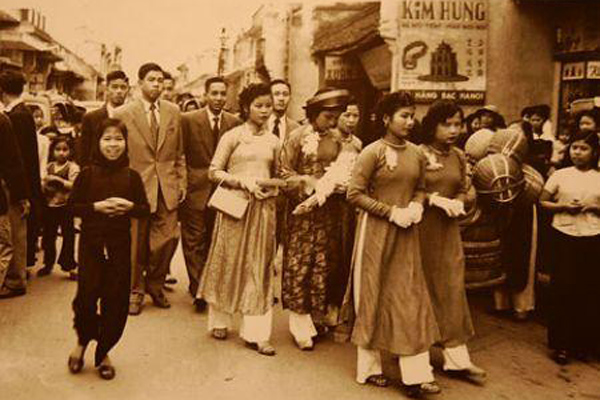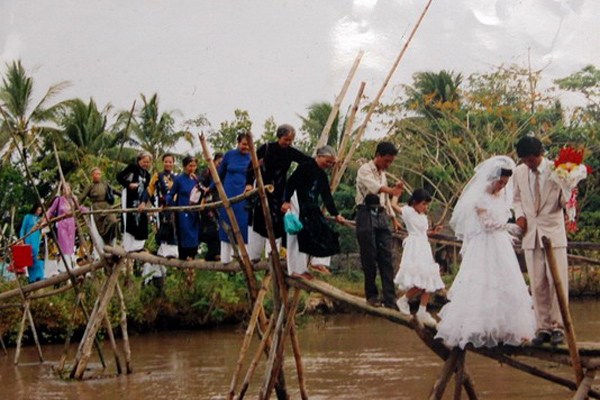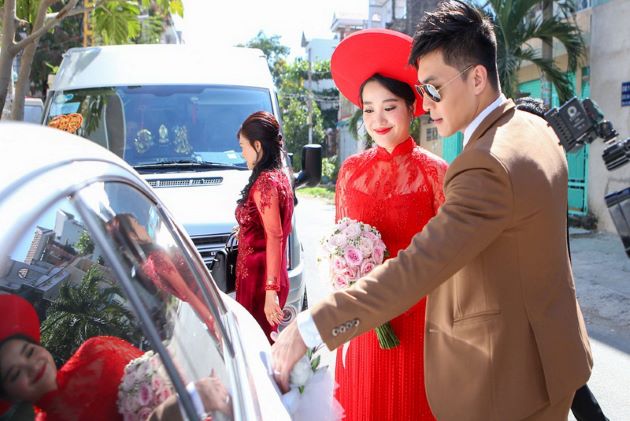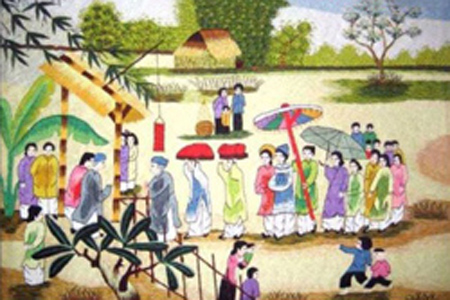It's now peak time for the "wedding season” — the "season of crimson kakis and green rice flakes" which begins in the Eighth Lunar Month. In sharp contrast to the spartan "New Life" style adopted after the August Revolution of 1945 and that remained very strong throughout the two wars of resistance, people in both cities and the countryside have converted to very old-fashioned practices, vying in observing all the four big ceremonies from the old days.
The First Wedding Ceremony in Vietnam
The first would be an introduction ceremony called Le xem mat (face to face) conducted after the match-maker has got the agreement of the fiancee's family. The man’s family would make a visit, bringing gifts of tea and areca nuts, and the two young people would be allowed to have a brief look at each other.

The Second Vietnamese Wedding Ceremony
Next would come to the engagement ceremony (in Vietnamese an hoi which means "asking for marriage"). This time the man’s family would be required to bring areca nuts and betel leaves, tea, pork, glutinous rice, an even number of glutinous rice cakes (banh day), an equal number of square cakes (banh chung), rice flake cakes, and many other gifts, all wrapped in red paper and tied with red- painted bamboo strips and placed in huge red lacquer boxes (qua) carried by people wearing red sashes over their dresses. Part of the gifts would be returned (lai qua) to the fiancés family for distribution among relatives in lieu of invitation cards.
Pending the wedding, the fiancé would be required to thank his future in-laws by bringing seu consisting of fruits in season, new rice, several braces of turtle-doves, preserved fruit, confectioneries, tea, and so on. The gifts would have to be made on all festive occasions (the Lunar New Year, the Fifth Day of the Fifth Month, the 15th Day of the Seven Month, the Mid-Autumn Festival) as well as on the death anniversaries of her ancestors. In some cases the fiancé would be asked to live for a certain period with his future in-laws in the practice of lam re (bridegroom in apprenticeship), working without pay.
The Third Wedding Ceremony in Vietnam
It would be for marriage planning (le cuoi), to take place one year or three after engagement and preceded by an exchange of letters (proposition and affirmative answer written on scarlet paper) and of gifts. The fiancées family would then set the terms (thach cuoi), asking for solid gold, jewels, cash, clothes, rice, alcohol, meat, and many other things, sometimes so much that the other party had to call off everything.

The Fouth Vietnamese Wedding Ceremony
The wedding ceremony would be the last major event. The wedding procession (dam cuoi) would start from the fiancé’s house. It would be led by a man, respected by the community for his age and his large family, holding in front of him a bunch of burning incense sticks, followed by gift bearers, relatives, and friends.
The fiancée’s home would then be the scene of Te To Hong (Offerings to the Genius of the Red Thread), a ceremony mainly acted out by the two principals.
The Last Wedding Ceremony in Vietnam
Le dua dau (Sending-Off for the Bride) would take place the following day, with the two families joining in a lavish meal. On the way back the procession would be halted from time to time by a long piece of red thread strung across the road by curious crowds and would then have to pay a few speaks for passage.

In the evening another rite would have to be performed. Called giau tram, it consisted of making the bride share with the bridegroom one hundred betel quids and one cup of ruou hop can (a cup of alcohol sealing the union).
Then the woman would prostrate twice before the man, who would return the obeisance each time with equal solemnity. Post-nuptial rites are no less onerous and I’ll spare you the telling, knowing you’ll agree that marital happiness is not something one can buy, even with all the wealth of the world.
Much as I appreciate all effort at defending good customs from the assault of shrill modernism, I’m strongly against the revival of anachronistic practices by upstarts to display their new wealth.



